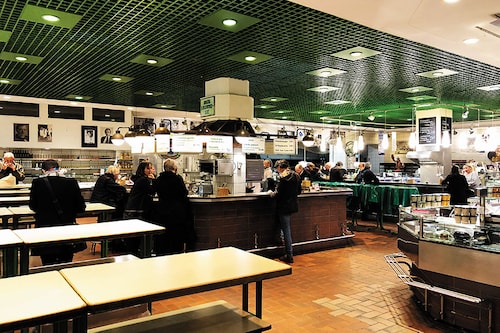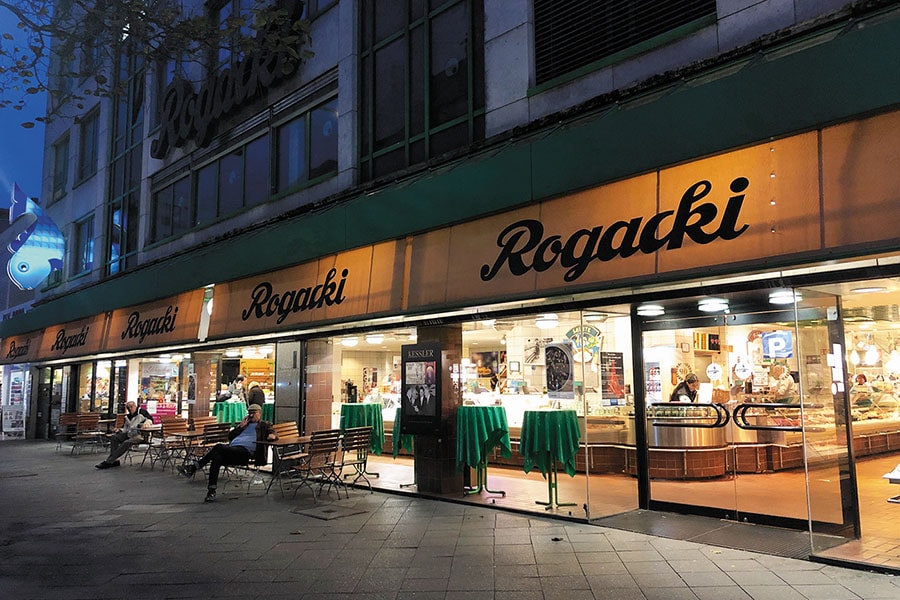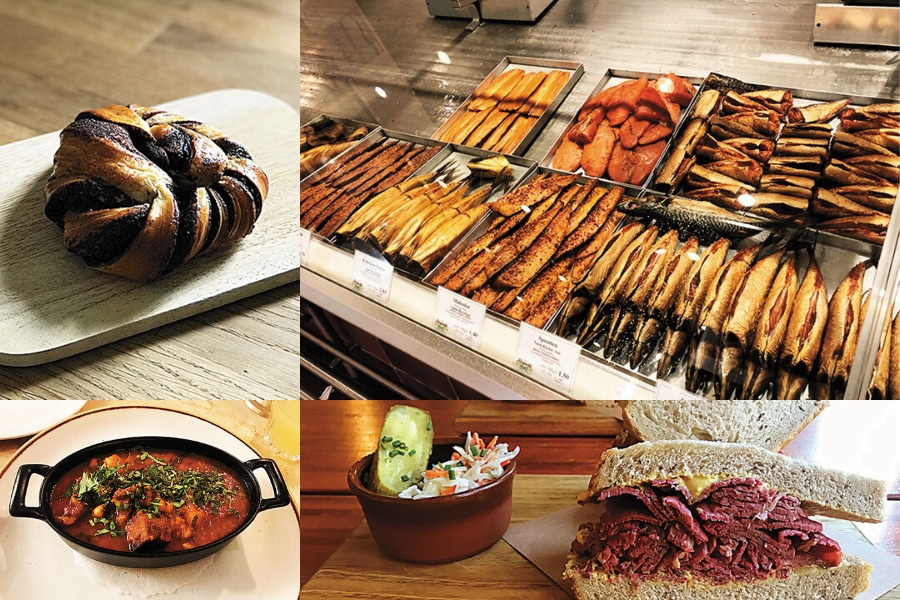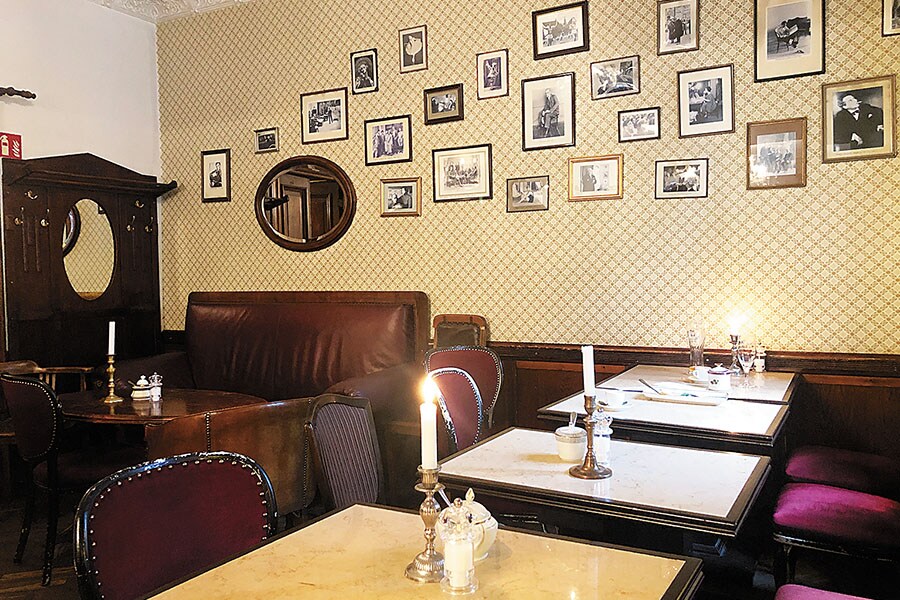Exploring the best of Berlin's growing Jewish food scene
The German city, which has always attracted youngsters from around the world, is seeing a rise in popularity among people from Israel, contributing to Levantine food's trendiness in the region


.jpg) Rogacki first opened its doors in 1928. It has many delicacies that overlap with Jewish cuisine
Rogacki first opened its doors in 1928. It has many delicacies that overlap with Jewish cuisine
Some of my earliest food memories are of cravings for things that I hadn’t even tasted. Archie comics made me crave whole glazed hams, eaten in one go, Jughead Jones-style. Enid Blyton made me yearn for root beer, potted meat, and sausages bursting in their skins. And eventually, American sitcoms, especially Seinfeld, caused my appetite to grow further. If it wasn’t the crab bisque served by the despotic chef they called ‘The Soup Nazi’, it was the latkes that Mr Costanza whipped up. And then there was the chocolate babka—that glorious baked treat that they dedicated an entire episode to. To say that the show, and the babka, piqued my interest in Jewish cuisine is an understatement.
It was a windy September day in Berlin when I alighted at the Warschauer Strasse train station and made my way towards one of the city’s more popular English-language bookstores, Shakespeare and Sons. While I love bookstores, this trip wasn’t entirely inspired by my love for the written word. A large sign board outside the store read ‘Books and Bagels’, and my curiosity was centred on the latter. In 2013, Laurel Kratochvila, who owns Shakespeare and Sons with her husband Roman, was absolutely disgusted by what Berliners were doing to the bagel—they weren’t just inauthentic, they were terrible. But since she came from a family of bakers, had trained at Le Cordon Bleu in France, and also had an inherent love for the bagel, Kratochvila decided to do something about it. So she annexed a small portion of the cash counter, and started serving up proper New York-style, hand-rolled, boiled-then-baked bagels. Bagels that have since gained the reputation of being the very best that Berlin has to offer. I scanned the exhaustive list of bagels and ‘schmear’ on offer, and settled on a plain bagel with cream cheese, and an onion bagel. Then I spotted the words I’d been hoping to see: Chocolate babka.
Half an hour later I was at home, waiting for a pot of coffee to brew, with the hallowed babka resting on a breakfast board and the bagels already lighter by a couple of bites. After having the cup of coffee, I settled down with the babka. It had the texture of bread or a brioche, but tasted in parts like a dense chocolate cake. Each chewy mouthful lasted a while, and it managed to be rich without feeling too decadent. At the time of writing this article, several bagels and babkas and some challah and rugelach later, I understand why Fine Bagels has become the go-to place for Jewish baked goods in Berlin.
To continue my quest for the best Jewish food in the city, I turned to Liv Fleischhacker, 31, the Berlin-based author of Mazel Tov, a guide to modern Jewish cooking around the world. She and Kratochvila also organised ‘Nosh’ (the Yiddish word for snack), Berlin’s only Jewish food festival. After organising two editions of the festival, they are hoping to get funding for a third. Growing up in Berlin, the grand-daughter of Holocaust survivors, Fleischhacker tells me that she was always aware of her Jewish heritage. Her grandfather even served as a zeitzeuge (‘time witness’), someone who has lived through certain historical events and is thus qualified to make people aware about that particular period of time.
“So, being Jewish was always a thing. We talked about it over family meals, but my grandparents didn’t cook Jewish food. They didn’t cook very much, actually. And there were no Jewish restaurants and delis in Berlin in the early ’90s for obvious reasons,” Fleischhacker says. It was only when she began her career as a food writer that she began thinking of her own identity, asking herself, “What is my own food culture?” The answers she sought led her on a journey that included honey-spiced cake usually eaten for Passover, warm pastrami with mustard, matzo ball soup, gefilte fish, and much more.
Not long after my conversation with Fleischhacker, I make my way to Mogg, a deli housed in an old red-brick building that was once a Jewish Girls school on Auguststrasse in Mitte. With simple long tables and benches and a cafeteria-style counter, there’s a rather no-nonsense Berlin feel to Mogg. But from the moment I walk in, something smells very, very good. I barely need to look at the menu, because I know exactly what it is that I’m there to eat: Their famous pastrami—that, I’m told, is brined and smoked in-house—on rye. Clockwise from top left: chocolate babka from Fine Bagels, assorted smoked fish from Rogacki, The Mogg pastrami on rye and lamb stew with chickpeas
Clockwise from top left: chocolate babka from Fine Bagels, assorted smoked fish from Rogacki, The Mogg pastrami on rye and lamb stew with chickpeas
While the portions at Mogg are known to be generous, I wasn’t prepared for just how generous they would be. If I’d stacked the two half-sandwiches, stuffed thick with beautiful pink pastrami, one on top of the other, they would have been as big as my head. And this was their ‘small’ option. The pastrami was warm and marbled with fat, the mustard was just sharp enough to cut the richness of the meat, and the salad-and-pickle was perfect for tiny nibbles. That meal filled my stomach, satisfied my soul, but unfortunately left no room for their equally famous matzo ball soup.
I ask Fleischhacker what’s led to the growing popularity of Jewish food all over the world. “It’s fatty and salty, I think that helps,” she laughs. But, she also points out that the deli style of service is convenient. “Even if you’re not going there for a five-hour meal, you can sit there, have someone take care of you, and have a warm soup on a cold day. It’s a little bit of comfort. Or if you want to pop in, get a sandwich, and pop out again, you can also do that.”
Then there’s the fact that Jewish cuisine has grown in popularity across the US, and the US in turn wields considerable influence on popular global culture. “The fact that Germans look at ‘deli’, which is a German word ‘deli’,” she emphasises, “and see it as American, whereas technically it came from Europe, is bonkers.” It was Ashkenazi Jewish food that originated in Eastern Europe, and then travelled from Poland to America, where it became the popular deli food that we know of today, before taking a circuitous route to Berlin.
But deli food is certainly not the only type of Jewish cuisine in the city. Restaurant Pasternak, named after Russian author Boris Pasternak, is a charming, old-school eatery that’s located at the corner of Knaackstrasse, fairly close to Synagogue Rykestrasse, Germany’s largest synagogue. The establishment serves Russo-Jewish food, and features a seasonal menu that extends from the traditional Russian borscht and soljanka, to Jewish specialities like kreplach dumplings, pargit steak and latkes. It also happens to be one of the few places in Berlin where you can actually get the famed Jewish fish dumplings or gefilte fish. There are also dishes with both Israeli and Sephardic influences, like the adafina—a thick stew with chickpeas and meat, often lamb. They also do a range of vodka cocktails that are just right when the weather’s turned cold, and very helpful when it comes to washing down their sweet almond curd and raspberry blinis. Pasternak serves Russo-Jewish food
Pasternak serves Russo-Jewish food
There is another reason for the massive rise in Jewish cuisine in Berlin. The city has always attracted youngsters from around the world, who’ve been drawn to its vibrant art, music and culture scene. And that young population includes a number of people from Israel. Add to that the fact that chef Yotam Ottolenghi and his recipes have become increasingly famous over the past decade—Levantine food is definitely trendy now. “The fact that Ottolenghi became so popular definitely plays into people wanting to make hummus at home,” Fleischhacker says. “In the early 2000s, when we wanted to make hummus at home, we could only get chickpea canisters of a kilogramme or so, and that too from specialty shops. Whereas now Rewe [a German supermarket chain] has cans of chickpeas. So things are changing quite quickly.”
But it isn’t just chickpeas that you can find at most supermarkets in Berlin you’re almost certain to find tubs of hummus as well. However, if you are not hankering after store-bought hummus, Berlin’s got you covered. Kanaan, started by Oz Ben David, an Israeli entrepreneur, and Jalil Dabit, a restaurateur from Palestine, claims to serve “the best hummus in town”. The Prenzlauer Berg restaurant that serves vegetarian and vegan food has become massively popular over the five years that it’s been open. Go there for a weekend brunch of an assortment of salads and dips, eggless omelettes, and shakshuka. Or stop by for dinner with food of both Israeli and Palestinian origins. There’s stuffed pine leaves, several hummus options, and even a twist on the Berlin currywurst, complete with a vegan sausage.
And where Kanaan is every inch a reflection of Berlin’s hipster vibe, Rogacki is an establishment that takes you back in time. Located in the more upmarket Charlottenberg area, it is a humongous delicatessen that first opened its doors in 1928. It isn’t Jewish per say, but as Fleischhacker explains, “It has so many foods that overlap with Jewish cuisine.” Today, it’s considered something of a West Berlin institution, also put on the map by the considerable praise Anthony Bourdain, the late American celebrity chef and author, once heaped on it. While the front of the store has a section of wine, cheese, meat, and charcuterie, the true treasures await in the large hall at the back. Rockagi’s speciality is the smoked eel and fish that are made there, in its capacious smoke rooms, every single day. But there are endless other options: Soused herring or matjes, cod fillets, pikeperch, lobster, prawns (many places that serve Jewish food in Berlin are not strictly kosher), oyster, head cheese or sülze… the list goes on.
In the centre is an area where you can stand and eat what you’ve ordered from the cafeteria-style counters that line the room. And looking at the people in the centre of that room, I realised that Rogacki caters to as wide a variety of people as the food it has on offer. It doesn’t just cater to the older Berliner, who leaves with a bag of meat and fish for to cook up a feast at home. It isn’t appealing only to the individual who stands there washing down oysters with some white wine. And it isn’t just a stop for the hungry office-goer who has nipped over for a quick, fuss-free lunch of fried plaice or scholle fish with potatoes. Nor is it a place that draws the attention of just camera-toting tourists.
Instead, right there, is a metaphor for Berlin itself. A big, cosmopolitan melting pot. And it also reminds me of the way food brings different people together. The way the smell of cooking can often stir in us a longing. And the way that meals you’ve never had, but only read of in books and watched on television, can cause a lifelong hunger that might someday be satiated.
First Published: Mar 07, 2020, 10:00
Subscribe Now